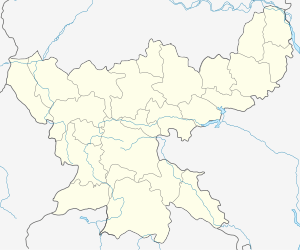Pakuria block
Pakuria is a community development block that forms an administrative division of Pakur district, Jharkhand state, India. It is located 46 km from Pakur, the district headquarters.pakuria is exactly 52km from the pakur district-Pakur
Pakuria van pakuria | |
|---|---|
Community development block | |
 Pakuria Location in Jharkhand, India | |
| Coordinates: 24°20′0″N 87°39′9″E | |
| Country | |
| State | Jharkhand |
| District | Pakur |
| Elevation | 146 m (479 ft) |
| Population (2011) | |
| • Total | 108,576 |
| Literacy (2011) | |
| • Total literates | 47,945 (53.82%) |
| Time zone | UTC+5:30 (IST) |
| PIN | 816117 (Pakuria) |
| Telephone/STD code | 06423 |
| Vehicle registration | JH-16 |
| Lok Sabha constituency | Rajmahal |
| Vidhan Sabha constituency | Maheshpur |
| Website | pakur |
| CD Block | |
Geography
Pakuria, the eponymous CD Block headquarters, is located at 24°20′0″N 87°39′9″E.[1]
Pakuria CD Block covers an area of 279.01 km2 and has 18 panchayats, 148 inhabited (chiragi) villages and 8 uninhabited (bechiragi) villages.[2]
Demographics
As per 2011 Census of India, Pakuria CD Block had a total population of 108,576, all of which were rural. There were 54,181 (50%) males and 54,395 (50%) females. Population below 6 years was 19,484. Scheduled Castes numbered 3,268 and Scheduled Tribes numbered 69,680.[3]
In 2011 census Pakuria (village) had a population of 3,234.[3]
In 2001 census, Hindus constituted 47.15%, Muslims 15.16%, Christians 6.5% and others 30.84% of the population in Pakuria CD Block. In the district as a whole Hindus constituted 44.45%, Muslims 32.74% and Christians 6.01% of the population. The percentage of scheduled tribes in the population of Pakuria CD block was 64.35%. In the district as a whole scheduled tribes constituted 44.59% of the population. Around 85% of the tribal population was composed of Santhals. There are two primitive groups – Mal Paharias and Sauria Paharias.[2]
Literacy
As of 2011 census, the total number of literates in Pakuria CD Block was 47,945 (53.82% of the population over 6 years) out of which 28,865 (60%) were males and 19,080 (40%) were females.[3]
As of 2011 census, literacy in Pakur district was 48.82.[4]Literacy in Jharkhand (for population over 7 years) was 66.41% in 2011.[5]Literacy in India in 2011 was 74.04%.[6]
Economy
Predominantly agricultural district
Pakur is predominantly a hilly district. There is a narrow fertile alluvial tract bordering the Ganges Feeder Canal. While the hills stretch from the north to the south-east, the rest is rolling area, which is less conducive to agricultural operations than the alluvial tract. The net sown area of the district is around 28%. Thus though the district is predominantly agricultural it offers only limited opportunities to the people. Many people from the district migrate to the neighbouring districts of West Bengal during the agricultural seasons.[2]
Stone chips industry
Pakur is a centre of mining of black stone which is in great demand in the construction industry. There are four main circles for mining of stone – Pakur, Hiranpur, Mahespur and Pakuria. Stone chips are mined in Pakuria circle at villages such as Chandana, Golpur, Jharia, Khaksa, Khagachua and Matiachuan.[7]
References
- "Pakuria". Jharkhand. Wikimapia. Retrieved 17 January 2016.
- "Table 1.3: Select indicators of the administrative blocks, 2001" (PDF). District Human Development Report, Pakur. Pakur District Administration. Archived from the original (PDF) on 28 January 2016. Retrieved 17 January 2016.
- "2011 Census C.D. Block Wise Primary Census Abstract Data(PCA)". Jharkhand – District-wise CD Blocks. Registrar General and Census Commissioner, India. Retrieved 17 January 2016.
- "District Census 2011". Population Census 2011. Retrieved 17 January 2016.
- "Jharkhand Profile" (PDF). Census Info India 2011 – Final population totals. Census Commissioner, Government of India. Retrieved 17 January 2016.
- "Literacy in India". Census 2011. Census population 2015 data. Retrieved 17 January 2016.
- "List of mining leases area-wise". Pakur District Administration. Archived from the original on 7 January 2016. Retrieved 17 January 2016.